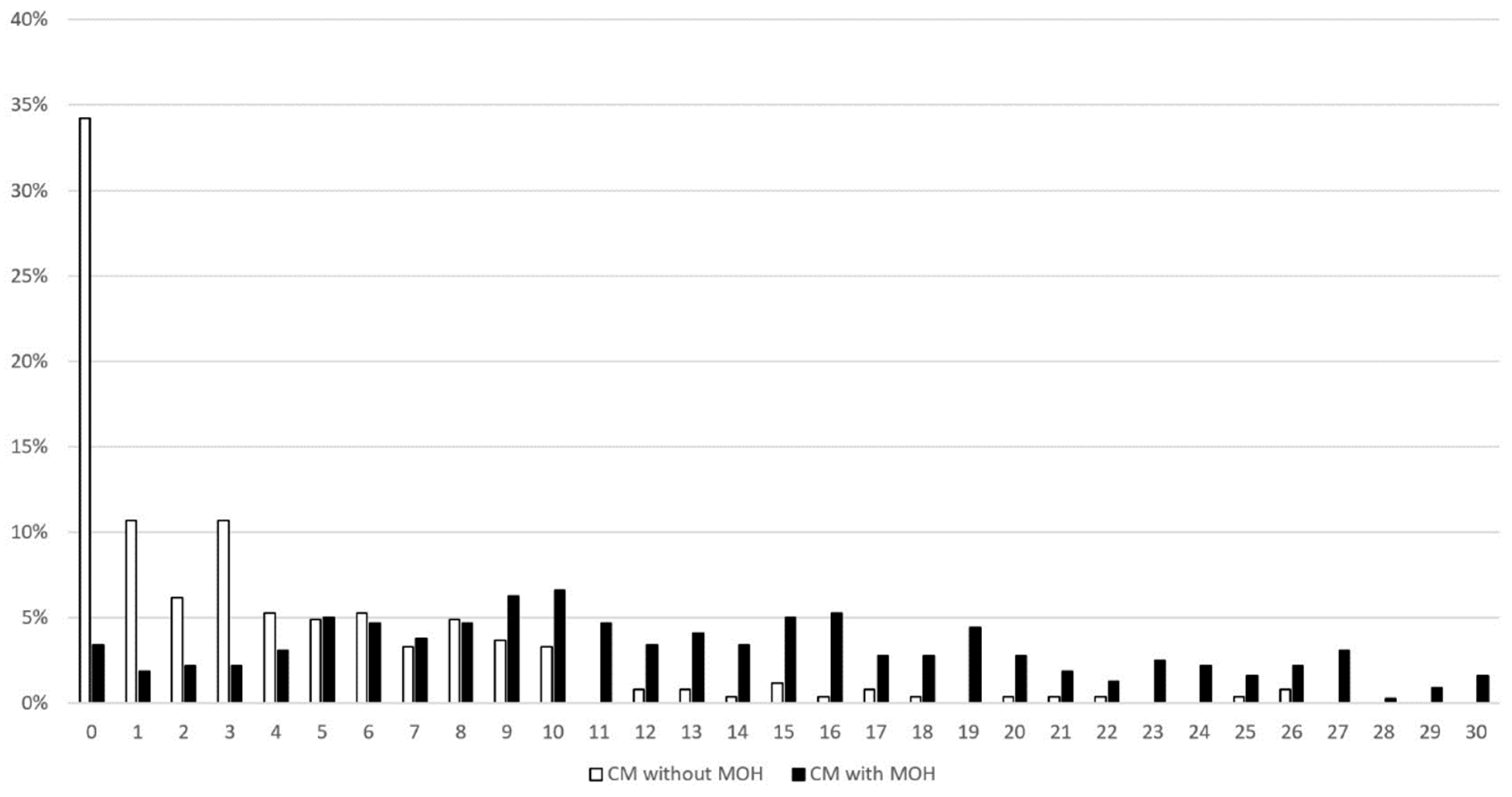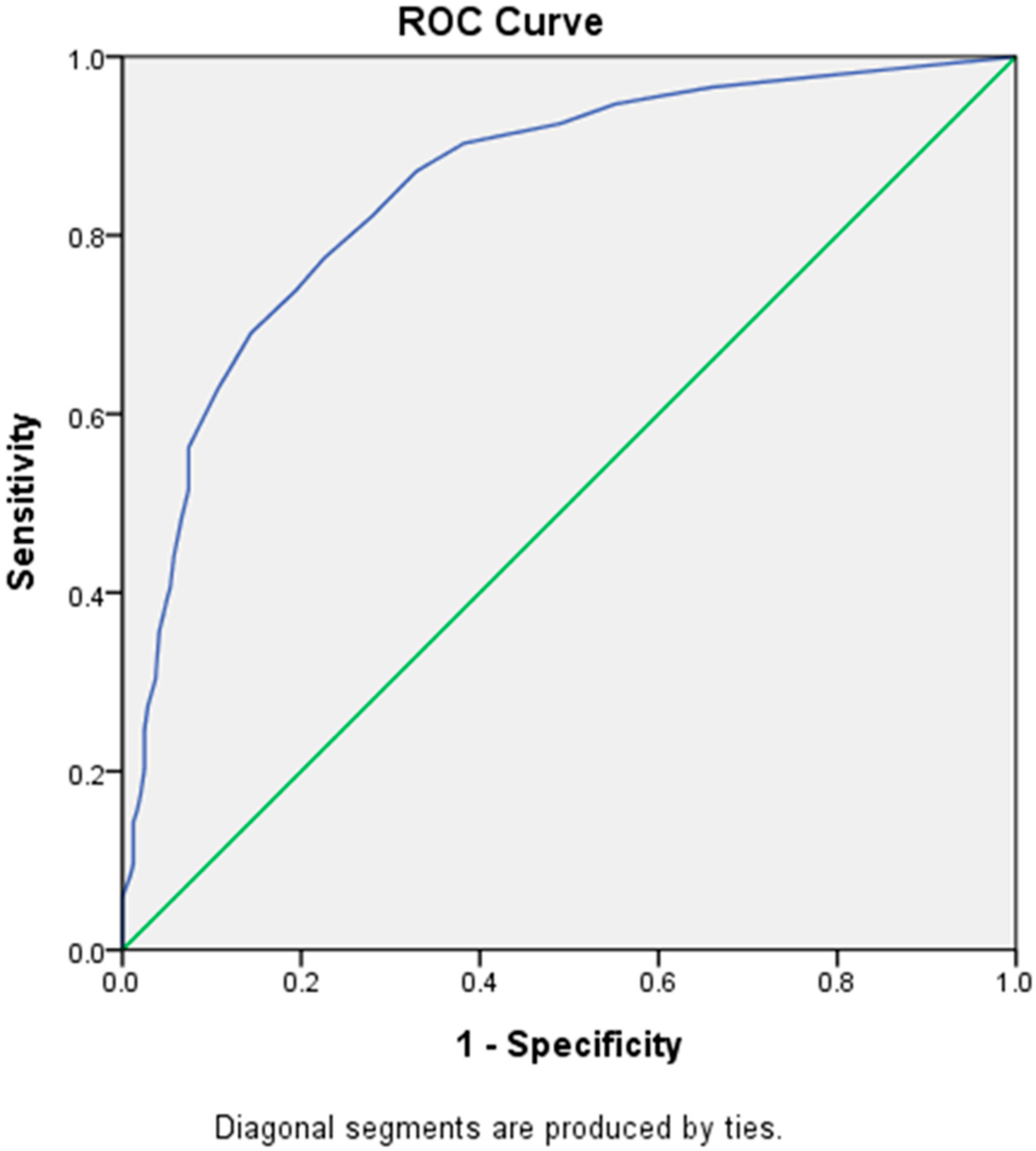Clinical Utility of Leeds Dependence Questionnaire in Medication-Overuse Headache
Abstract
1. Introduction
2. Methods
2.1. Patients
2.2. Questionnaire-Based Interviews
2.3. Statistical Analysis
3. Results
3.1. Demographics and Clinical Characteristics
3.2. Dependence Behavior
3.3. Clinical Utility of LDQ
4. Discussion
Author Contributions
Funding
Institutional Review Board Statement
Informed Consent Statement
Data Availability Statement
Acknowledgments
Conflicts of Interest
References
- Diener, H.C.; Dodick, D.; Evers, S.; Holle, D.; Jensen, R.H.; Lipton, R.B.; Porreca, F.; Silberstein, S.; Schwedt, T. Pathophysiology, prevention, and treatment of medication overuse headache. Lancet Neurol. 2019, 18, 891–902. [Google Scholar] [CrossRef]
- Katsarava, Z.; Muessig, M.; Dzagnidze, A.; Fritsche, G.; Diener, H.C.; Limmroth, V. Medication overuse headache: Rates and predictors for relapse in a 4-year prospective study. Cephalalgia 2005, 25, 12–15. [Google Scholar] [CrossRef]
- Chen, P.K.; Wang, S.J. Medication Overuse and Medication Overuse Headache: Risk Factors, Comorbidities, Associated Burdens and Nonpharmacologic and Pharmacologic Treatment Approaches. Curr. Pain Headache Rep. 2019, 23, 60. [Google Scholar] [CrossRef]
- Wang, S.J.; Fuh, J.L.; Lu, S.R.; Liu, C.Y.; Hsu, L.C.; Wang, P.N.; Liu, H.C. Chronic daily headache in Chinese elderly: Prevalence, risk factors, and biannual follow-up. Neurology 2000, 54, 314–319. [Google Scholar] [CrossRef]
- Lu, S.R.; Fuh, J.L.; Chen, W.T.; Juang, K.D.; Wang, S.J. Chronic daily headache in Taipei, Taiwan: Prevalence, follow-up and outcome predictors. Cephalalgia 2001, 21, 980–986. [Google Scholar] [CrossRef]
- Wang, S.J.; Fuh, J.L.; Lu, S.R.; Juang, K.D. Chronic daily headache in adolescents: Prevalence, impact, and medication overuse. Neurology 2006, 66, 193–197. [Google Scholar] [CrossRef]
- Vandenbussche, N.; Laterza, D.; Lisicki, M.; Lloyd, J.; Lupi, C.; Tischler, H.; Toom, K.; Vandervorst, F.; Quintana, S.; Paemeleire, K.; et al. Medication-overuse headache: A widely recognized entity amidst ongoing debate. J. Headache Pain 2018, 19, 50. [Google Scholar] [CrossRef]
- GBD 2015 Neurological Disorders Collaborator Group. Global, regional, and national burden of neurological disorders during 1990-2015: A systematic analysis for the Global Burden of Disease Study 2015. Lancet Neurol. 2017, 16, 877–897. [Google Scholar] [CrossRef]
- Diener, H.C.; Holle, D.; Solbach, K.; Gaul, C. Medication-overuse headache: Risk factors, pathophysiology and management. Nat. Rev. Neurol. 2016, 12, 575–583. [Google Scholar] [CrossRef]
- Minen, M.T.; Begasse De Dhaem, O.; Kroon Van Diest, A.; Powers, S.; Schwedt, T.J.; Lipton, R.; Silbersweig, D. Migraine and its psychiatric comorbidities. J. Neurol. Neurosurg. Psychiatry 2016, 87, 741–749. [Google Scholar] [CrossRef]
- Dresler, T.; Caratozzolo, S.; Guldolf, K.; Huhn, J.I.; Loiacono, C.; Niiberg-Pikksoot, T.; Puma, M.; Sforza, G.; Tobia, A.; Ornello, R.; et al. Understanding the nature of psychiatric comorbidity in migraine: A systematic review focused on interactions and treatment implications. J. Headache Pain 2019, 20, 51. [Google Scholar] [CrossRef]
- Fuh, J.L.; Wang, S.J.; Lu, S.R.; Juang, K.D. Does medication overuse headache represent a behavior of dependence? Pain 2005, 119, 49–55. [Google Scholar] [CrossRef]
- Radat, F.; Creac'h, C.; Guegan-Massardier, E.; Mick, G.; Guy, N.; Fabre, N.; Giraud, P.; Nachit-Ouinekh, F.; Lanteri-Minet, M. Behavioral dependence in patients with medication overuse headache: A cross-sectional study in consulting patients using the DSM-IV criteria. Headache 2008, 48, 1026–1036. [Google Scholar] [CrossRef]
- Bottiroli, S.; Galli, F.; Ballante, E.; Pazzi, S.; Sances, G.; Guaschino, E.; Allena, M.; Tassorelli, C. Validity of the Severity of Dependence Scale for detecting dependence behaviours in chronic migraine with medication overuse. Cephalalgia 2022, 42, 209–217. [Google Scholar] [CrossRef]
- Radat, F.; Creac'h, C.; Swendsen, J.D.; Lafittau, M.; Irachabal, S.; Dousset, V.; Henry, P. Psychiatric comorbidity in the evolution from migraine to medication overuse headache. Cephalalgia 2005, 25, 519–522. [Google Scholar] [CrossRef]
- Fumal, A.; Laureys, S.; Di Clemente, L.; Boly, M.; Bohotin, V.; Vandenheede, M.; Coppola, G.; Salmon, E.; Kupers, R.; Schoenen, J. Orbitofrontal cortex involvement in chronic analgesic-overuse headache evolving from episodic migraine. Brain 2006, 129 Pt 2, 543–550. [Google Scholar] [CrossRef]
- Lai, T.H.; Chou, K.H.; Fuh, J.L.; Lee, P.L.; Kung, Y.C.; Lin, C.P.; Wang, S.J. Gray matter changes related to medication overuse in patients with chronic migraine. Cephalalgia 2016, 36, 1324–1333. [Google Scholar] [CrossRef]
- Volkow, N.D.; Fowler, J.S. Addiction, a disease of compulsion and drive: Involvement of the orbitofrontal cortex. Cereb. Cortex 2000, 10, 318–325. [Google Scholar] [CrossRef]
- Schoenbaum, G.; Shaham, Y. The role of orbitofrontal cortex in drug addiction: A review of preclinical studies. Biol. Psychiatry 2008, 63, 256–262. [Google Scholar] [CrossRef]
- Ferrari, A.; Cicero, A.F.; Bertolini, A.; Leone, S.; Pasciullo, G.; Sternieri, E. Need for analgesics/drugs of abuse: A comparison between headache patients and addicts by the Leeds Dependence Questionnaire (LDQ). Cephalalgia 2006, 26, 187–193. [Google Scholar] [CrossRef]
- Grande, R.B.; Aaseth, K.; Saltyte Benth, J.; Gulbrandsen, P.; Russell, M.B.; Lundqvist, C. The Severity of Dependence Scale detects people with medication overuse: The Akershus study of chronic headache. J. Neurol. Neurosurg. Psychiatry 2009, 80, 784–789. [Google Scholar] [CrossRef]
- Lundqvist, C.; Grande, R.B.; Aaseth, K.; Russell, M.B. Dependence scores predict prognosis of medication overuse headache: A prospective cohort from the Akershus study of chronic headache. Pain 2012, 153, 682–686. [Google Scholar] [CrossRef]
- Lundqvist, C.; Gossop, M.; Russell, M.B.; Straand, J.; Kristoffersen, E.S. Severity of Analgesic Dependence and Medication-overuse Headache. J. Addict. Med. 2019, 13, 346–353. [Google Scholar] [CrossRef]
- Raistrick, D.; Bradshaw, J.; Tober, G.; Weiner, J.; Allison, J.; Healey, C. Development of the Leeds Dependence Questionnaire (LDQ): A questionnaire to measure alcohol and opiate dependence in the context of a treatment evaluation package. Addiction 1994, 89, 563–572. [Google Scholar] [CrossRef]
- Anonymous; Anonymous. Headache Classification Committee of the International Headache Society (IHS) The International Classification of Headache Disorders, 3rd edition. Cephalalgia 2018, 38, 1–211. [Google Scholar] [CrossRef]
- Stewart, W.F.; Lipton, R.B.; Kolodner, K.B.; Sawyer, J.; Lee, C.; Liberman, J.N. Validity of the Migraine Disability Assessment (MIDAS) score in comparison to a diary-based measure in a population sample of migraine sufferers. Pain 2000, 88, 41–52. [Google Scholar] [CrossRef]
- Zigmond, A.S.; Snaith, R.P. The hospital anxiety and depression scale. Acta Psychiatr. Scand. 1983, 67, 361–370. [Google Scholar] [CrossRef]
- Buysse, D.J.; Reynolds, C.F., 3rd; Monk, T.H.; Berman, S.R.; Kupfer, D.J. The Pittsburgh Sleep Quality Index: A new instrument for psychiatric practice and research. Psychiatry Res. 1989, 28, 193–213. [Google Scholar] [CrossRef]
- Mandrekar, J.N. Receiver operating characteristic curve in diagnostic test assessment. J. Thorac. Oncol. 2010, 5, 1315–1316. [Google Scholar] [CrossRef]
- Lundqvist, C.; Benth, J.S.; Grande, R.B.; Aaseth, K.; Russell, M.B. An adapted Severity of Dependence Scale is valid for the detection of medication overuse: The Akershus study of chronic headache. Eur. J. Neurol. 2011, 18, 512–518. [Google Scholar] [CrossRef] [PubMed]
- Dousset, V.; Maud, M.; Legoff, M.; Radat, F.; Brochet, B.; Dartigues, J.F.; Kurth, T. Probable medications overuse headaches: Validation of a brief easy-to-use screening tool in a headache centre. J. Headache Pain 2013, 14, 81. [Google Scholar] [CrossRef] [PubMed]
- Silberstein, S.D.; Olesen, J.; Bousser, M.G.; Diener, H.C.; Dodick, D.; First, M.; Goadsby, P.J.; Gobel, H.; Lainez, M.J.; Lance, J.W.; et al. The International Classification of Headache Disorders, 2nd Edition (ICHD-II)—Revision of criteria for 8.2 Medication-overuse headache. Cephalalgia 2005, 25, 460–465. [Google Scholar] [CrossRef]
- Gossop, M.; Darke, S.; Griffiths, P.; Hando, J.; Powis, B.; Hall, W.; Strang, J. The Severity of Dependence Scale (SDS): Psychometric properties of the SDS in English and Australian samples of heroin, cocaine and amphetamine users. Addiction 1995, 90, 607–614. [Google Scholar] [CrossRef]
- May, A.; Schulte, L.H. Chronic migraine: Risk factors, mechanisms and treatment. Nat. Rev. Neurol. 2016, 12, 455–464. [Google Scholar] [CrossRef]
- Sances, G.; Ghiotto, N.; Galli, F.; Guaschino, E.; Rezzani, C.; Guidetti, V.; Nappi, G. Risk factors in medication-overuse headache: A 1-year follow-up study (care II protocol). Cephalalgia 2010, 30, 329–336. [Google Scholar] [CrossRef]



| Without MOH (n = 243) | With MOH (n = 320) | p Value | |
|---|---|---|---|
| Age | 40.8 ± 12.5 | 42.3 ± 11.6 | 0.152 |
| Female gender | 197 (81.1%) | 254 (79.4%) | 0.618 |
| Bachelor's degree or higher | 136 (56.0%) | 139 (43.4%) | 0.003 |
| Being married * | 117 (48.1%) | 163 (50.9%) | 0.512 |
| Being employed | 157 (64.6%) | 224 (70.0%) | 0.176 |
| Migraine with aura | 13 (5.3%) | 14 (4.4%) | 0.592 |
| Age at migraine onset (years) | 22.8 ± 10.8 | 20.7 ± 9.2 | 0.065 |
| Duration of CM (months) | 60.4 ± 112.4 | 90.4 ± 100.6 | <0.001 |
| Average headache intensity on NRS (0–10) | 6.2 ± 1.8 | 7.0 ± 1.9 | <0.001 |
| Monthly headache days | 23.0 ± 6.9 | 23.8 ± 6.5 | 0.315 |
| Monthly acute medication use (days/month) | 3.7 ± 5.3 | 19.4 ± 7.8 | <0.001 |
| MIDAS (range 0–270) | 42.5 ± 51.3 | 66.2 ± 77.4 | <0.001 |
| HADS-A (range 0–21) | 9.7 ± 4.2 | 9.6 ± 4.3 | 0.621 |
| HADS-D (range 0–21) | 7.3 ± 4.1 | 8.0 ± 1.7 | 0.210 |
| PSQI (range 0–21) | 11.1 ± 4.2 | 11.9 ± 4.4 | 0.030 |
| Modified Leeds Dependence Questionnaire | Without MOH | With MOH | p Value |
|---|---|---|---|
| 1. Do you find yourself thinking about when you will next be able to take analgesics? | 0.5 ± 0.8 | 1.3 ± 1.1 | <0.001 |
| 2. Is taking analgesics more important than anything else you might do during the day? | 0.4 ± 0.7 | 1.5 ± 1.1 | <0.001 |
| 3. Do you feel your need for analgesics is too strong to control? | 0.4 ± 0.7 | 1.6 ± 1.1 | <0.001 |
| 4. Do you plan your days around taking analgesics? | 0.2 ± 0.5 | 1.0 ± 1.1 | <0.001 |
| 5. Do you take analgesic in a particular way in order to increase the effect it gives you? | 0.2 ± 0.6 | 0.7 ± 1.0 | <0.001 |
| 6. Do you take analgesics morning, afternoon and evening? | 0.3 ± 0.5 | 1.3 ± 1.0 | <0.001 |
| 7. Do you feel you have to carry on taking analgesics once you have started? | 0.5 ± 0.8 | 1.3 ± 1.1 | <0.001 |
| 8. Is getting the effect you want more important than the particular analgesic you use? | 0.6 ± 0.9 | 1.6 ± 1.1 | <0.001 |
| 9. Do you want to take more analgesics when the effect starts to wear off? | 0.3 ± 0.6 | 1.1 ± 1.0 | <0.001 |
| 10. Do you find it difficult to cope with life without analgesics? | 0.5 ± 0.8 | 1.7 ± 1.1 | <0.001 |
| Total score (range 0–30) | 3.9 ± 5.1 | 13.0 ± 7.6 | <0.001 |
Disclaimer/Publisher’s Note: The statements, opinions and data contained in all publications are solely those of the individual author(s) and contributor(s) and not of MDPI and/or the editor(s). MDPI and/or the editor(s) disclaim responsibility for any injury to people or property resulting from any ideas, methods, instructions or products referred to in the content. |
© 2023 by the authors. Licensee MDPI, Basel, Switzerland. This article is an open access article distributed under the terms and conditions of the Creative Commons Attribution (CC BY) license (https://creativecommons.org/licenses/by/4.0/).
Share and Cite
Wang, Y.-F.; Tzeng, Y.-S.; Yu, C.-C.; Ling, Y.-H.; Chen, S.-P.; Lai, K.-L.; Wang, S.-J. Clinical Utility of Leeds Dependence Questionnaire in Medication-Overuse Headache. Diagnostics 2023, 13, 472. https://doi.org/10.3390/diagnostics13030472
Wang Y-F, Tzeng Y-S, Yu C-C, Ling Y-H, Chen S-P, Lai K-L, Wang S-J. Clinical Utility of Leeds Dependence Questionnaire in Medication-Overuse Headache. Diagnostics. 2023; 13(3):472. https://doi.org/10.3390/diagnostics13030472
Chicago/Turabian StyleWang, Yen-Feng, Yi-Shiang Tzeng, Chia-Chun Yu, Yu-Hsiang Ling, Shih-Pin Chen, Kuan-Lin Lai, and Shuu-Jiun Wang. 2023. "Clinical Utility of Leeds Dependence Questionnaire in Medication-Overuse Headache" Diagnostics 13, no. 3: 472. https://doi.org/10.3390/diagnostics13030472
APA StyleWang, Y.-F., Tzeng, Y.-S., Yu, C.-C., Ling, Y.-H., Chen, S.-P., Lai, K.-L., & Wang, S.-J. (2023). Clinical Utility of Leeds Dependence Questionnaire in Medication-Overuse Headache. Diagnostics, 13(3), 472. https://doi.org/10.3390/diagnostics13030472






